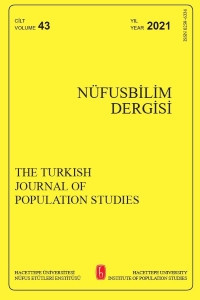SON DÖNEM OSMANLI NÜFUSU VE ETNİK DAĞILIMI
İmparatorluğun son yıllarında Osmanlı nüfusunun büyüklüğü ve etnik ve mekânsal dağılımı daha çok politik nedenlerle tartışmalı bir konu olagelmiştir. Osmanlılar nüfus sayımlarına ve bunların güncelleştirmelerine dayalı nüfus verileri üretirken çeşitli politik davaların taraftarları, kimi zaman resmi verilerden oldukça farklı rakamlar ileri sürmüşlerdir. Bu ihtilaflı rakamlar Osmanlı demografisi araştırmacıları için bir sorun arzetmektedir. Sorunun çözümünün düğüm noktası Osmanlı nüfus sayımlarının ve güncelleştirmelerinin doğruluk ya da güvenilirlik derecelerinin belirlenmesidir. Bu makalenin temel amacı budur. Sayım sonuçları üzerinde etkili olduklarından, makale önce Osmanlı nüfus sayım yöntem ve süreçleri üzerinde durmaktadır. Sayım sistemi kişilerin, özellikle erişkin erkeklerin, kaydolmaları için özendiriciler içeriyor ve sayımdan sorumlu komiteler, politik maksatlı veri üretimini engelleyici bir etnik yapıdan oluşuyordu. Ancak, kısmen kültürel nedenlerle, kadın ve çocuklar eksik sayılmışlardı. Sayımlardaki bu kusurlar, düzeltilebilecek niteliktedir. Model Hayat Tabloları kullanarak, eksik sayımları düzeltmek için biri İstanbul, biri de diğer vilayetler için olmak üzer iki yöntem geliştirilmiştir. Her sayım için, etnik grup ve idari birim itibariyle, biri de alt sınır biri de üst sınır olmak üzere iki tahmin yapılmıştır. Kadın ve çocukların eksik sayımları için düzeltmeler yapıldığında, Osmanlı nüfus sayımlarının makul ölçüde güvenilir belgeler oldukları ortaya çıkmaktadır.
LATE OTTOMAN POPULATION AND ITS ETHNIC DISTRIBUTION
The size and ethnic and spatial distribution of the Ottoman population during the last decades of the Empire has been a contentious issue, chiefly for political reasons. The Ottomans produced figures based on censuses and their updates while the protagonists of various political causes advanced their own numbers which at times differed considerably from the official ones. These conflicting numbers pose a problem for the students of Ottoman demography. The crux to the solution of the problem is the establishment of the degree of accuracy and of reliability of the Ottoman censuses and updated population registers. This is the main objective of the present study. The paper first discusses the Ottoman census methods and procedures as they had a bearing on the census counts. The system incorporated incentives for individuals, especially adult males, to register and the census committees responsible for the counts had an ethnic structure such as to prevent politically motivated constructions. However, partially for cultural reasons, women and children were undercounted. These deficiencies are amenable to correction. Two methods were devised; one for İstanbul and one for the rest of the vilayets, to correct for undercounts using Model Life Tables. Two estimates were made for each census count by principal ethnic group and administrative unit: a lower and an upper bound estimate. It is found that when corrected for undercounts of women and children, Ottoman censuses are reasonably reliable documents.
- ISSN: 0259-6334
- Başlangıç: 1979
- Yayıncı: Hacettepe Üniversitesi
